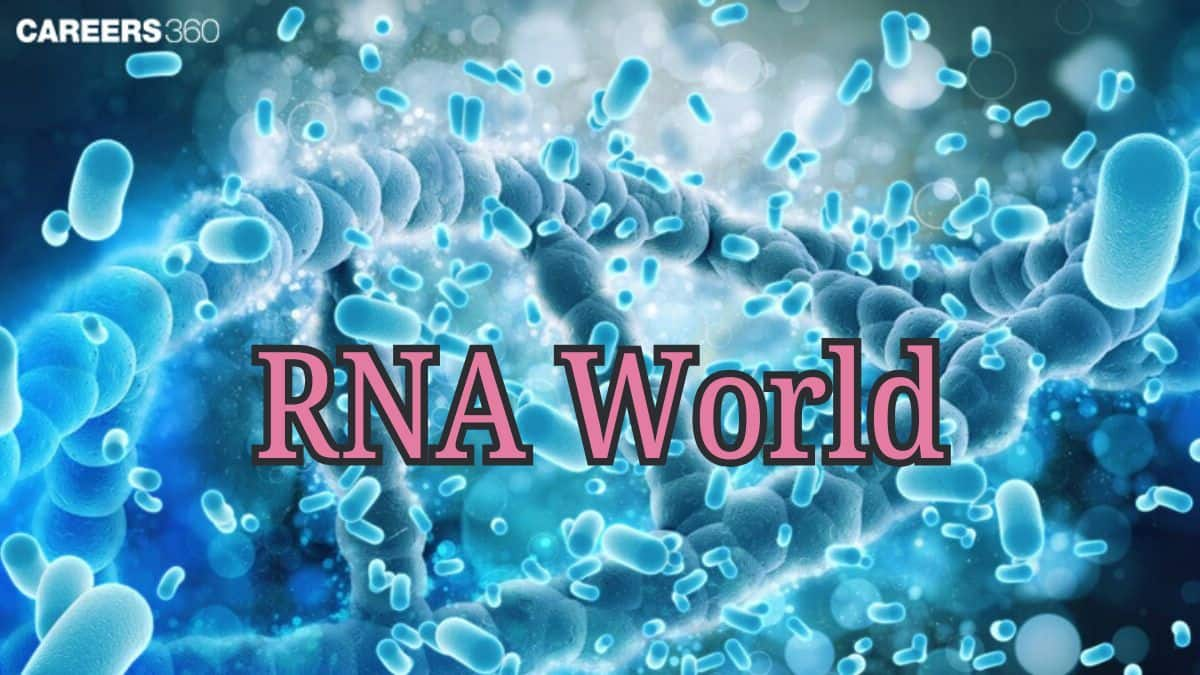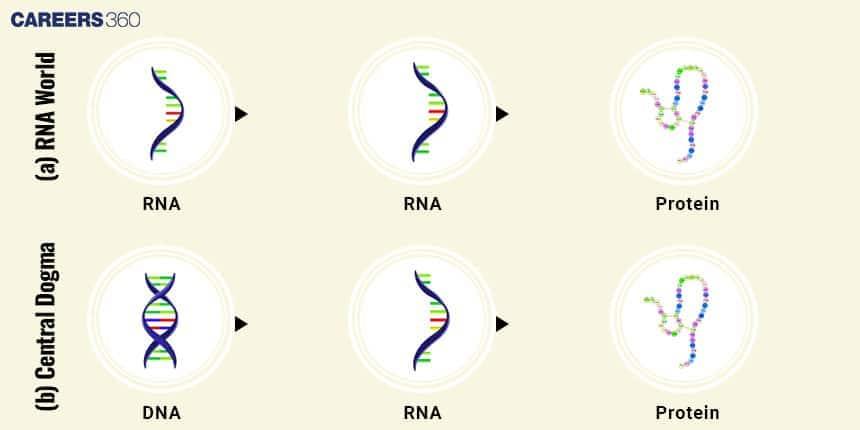RNA World - The Genetic Material and the Origins of Life
The RNA world hypothesis suggests that RNA was the first genetic material to exist before DNA and proteins. In the RNA world, RNA played both genetic and enzymatic roles. This theory provides understanding into the origin of life, explaining how simple molecules could have evolved into complex living organisms. In the RNA World, RNA held the genetic code for making proteins. The RNA world hypothesis explains the molecular basis of inheritance through RNA's role in storing genes.
This Story also Contains
- What is the RNA World Hypothesis?
- RNA World
- RNA Hypothesis Diagram
- Types of RNA
- Genetic Material RNA
- MCQs on RNA World

Scientists believe the RNA world existed before DNA and proteins evolved. In the RNA world, life was simpler and only used RNA molecules. The RNA world hypothesis suggests that RNA could replicate itself. This made the RNA world self-sufficient before DNA took over. In this article, the RNA world hypothesis, the RNA world, and types of RNA are discussed. RNA World is a topic of the chapter Molecular Basis of Inheritance in Biology.
What is the RNA World Hypothesis?
The RNA World Hypothesis proposes that RNA served as the first genetic material. The RNA World Hypothesis explains that RNA molecules played a central role in the early evolution of life on Earth. It is postulated that an RNA molecule can act as both a storage for genetic information and a bio-catalyst. The RNA World Hypothesis helps us understand the origin of life. It also explains how cells became more complex.
RNA World
According to the RNA World Hypothesis, RNA (ribonucleic acid) is a very important molecule that initially performed the living functions. It is a nucleic acid made by nucleotides. These include such things as sugar, a phosphate group, and bases (adenine, guanine, cytosine, and uracil). The RNA World Hypothesis helps explain how life began with just RNA molecules.
RNA Hypothesis Diagram
The diagram below shows the flow of genetic information as per the RNA world hypothesis and Central dogma of molecular biology. In the RNA world, RNA makes RNA and then proteins. In the central dogma, DNA makes RNA, and RNA makes proteins. This helps us understand how genetic information was passed in early life and in modern cells.

Types of RNA
There are three main types of RNA that help in protein synthesis. These are mRNA, tRNA, and rRNA, each with a special role in making proteins.
mRNA (Messenger RNA): Just carries genetic information from DNA, through ribosomes, to the synthesis of proteins.
tRNA (Transfer RNA): tRNA transfers amino acids to the ribosome during protein synthesis.
rRNA (Ribosomal RNA): It forms part of the ribosome, and functions in the synthesis of proteins.
Genetic Material RNA
RNAs are also considered catalysts for major biochemical reactions in primitive cells. In the RNA World, RNA worked as the first genetic material and also acted as a biocatalyst. The 2-OH group made RNA reactive but also unstable. This instability caused mutations, helping in evolution. Later, DNA replaced RNA as genetic material because DNA is more stable. Still, RNA remains important for storing and expressing genetic information in cells. The RNA World involved gene regulation and gene expression through RNA alone.
MCQs on RNA World
Question: Assertion: The RNA world hypothesis proposes that RNA was the first self-replicating molecule to emerge on Earth and played a critical role in the emergence of life.
Reason: RNA can act as both genetic material and enzymes, allowing it to self-replicate and catalyze chemical reactions, providing a pathway for the formation of more complex biomolecules.
Both the assertion and reason are true and the reason is a correct explanation of the assertion.
Both the assertion and reason are true, but the reason is not a correct explanation of the assertion.
The assertion is true, but the reason is false.
The assertion is false, but the reason is true.
Answer: Incorrect option 2 Both the assertion and reason are true, but the reason is not a correct explanation of the assertion is incorrect because the reason provided is a correct explanation of the assertion. RNA's ability to act as both genetic material and enzymes is a key characteristic that supports the RNA world hypothesis.
Incorrect option 3 The assertion is true, but the reason is false is incorrect because the reason provided is true. RNA's ability to act as both genetic material and enzymes is a key characteristic that supports the RNA world hypothesis.
Incorrect option 4 The assertion is false, but the reason is true is incorrect because the assertion is true. The RNA world hypothesis states RNA was the first self-replicating molecule to emerge on Earth and played a critical role in the emergence of life and the reason provided is also true.
Hence, the correct option is 1 Both the assertion and reason are true and the reason is a correct explanation of the assertion.
Question: Which of the following statements is true regarding the RNA world hypothesis?
A) RNA was the first genetic material to appear on Earth
B) RNA could self-replicate and catalyze chemical reactions
C) RNA was replaced by DNA as the primary genetic material in living organisms
D) RNA molecules were too unstable to play a role in the origin of life
Only A and B are true
Only B and C are true
Only A and D are true
Only C and D are true
Answer: Option 1 The RNA world hypothesis suggests that RNA was the first genetic material to appear on Earth, before the emergence of DNA and proteins. RNA is believed to have been able to self-replicate and catalyze chemical reactions, including the synthesis of other RNA molecules, which could have led to the emergence of life.
Explanation of incorrect option
Incorrect Option 2 Only B and C are true is incorrect because although RNA was able to self-replicate and catalyze chemical reactions leading to the emergence of life (as mentioned in option B), RNA was not replaced by DNA as the primary genetic material in all living organisms (as mentioned in option C).
Incorrect Option 3 Only A and D are true is incorrect because although RNA was the first genetic material to appear on Earth (as mentioned in option A), RNA molecules were not too unstable to play a role in the origin of life (as mentioned in option D).
Incorrect Option 4 Only C and D are true incorrect because RNA was not replaced by DNA as the primary genetic material in all living organisms (as mentioned in option C). In addition, RNA molecules were not too unstable to play a role in the origin of life (as mentioned in option D).
Hence, the correct answer is option 1) Only A and B are true
Question: The first genetic material could be:
Protein
Carbohydrates
DNA
RNA
Answer: The first genetic material is generally considered to be RNA, a concept supported by the RNA World Hypothesis. This hypothesis posits that RNA preceded DNA and proteins, serving as the original carrier of genetic data. RNA's significance is underscored by several key characteristics:
1. Genetic information storage: Similar to DNA, RNA can store and transmit genetic instructions.
2. Catalytic role: RNA molecules, specifically ribozymes, possess the ability to facilitate essential biochemical processes such as self-replication and the creation of peptide bonds.
3. Self-replication potential: Under appropriate conditions, RNA can replicate independently, which is a fundamental aspect of the development of early life.
These properties collectively suggest that RNA played a pivotal role in the evolution of life forms.
Hence, the correct answer is option (4) RNA.
Also Read:
Frequently Asked Questions (FAQs)
Some of the criticisms that come into play with the RNA World hypotheses are the stability of RNA under prebiotic settings and the ability for RNA self-replication in a manner of nowhere matching abiogenesis.
RNA is normally single-stranded in shape, contains ribose sugar, and uses uracil in place of thymine, while DNA is usually double-stranded in shape, contains deoxyribose sugar, and uses thymine.
RNA is believed to be the first genetic material because it can store genetic information and catalyse, both of these functions are required for the simplest life that existed during that period.